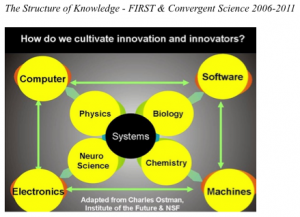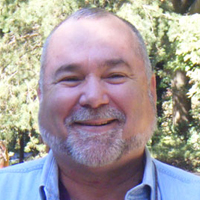
[Editor’s note: This is the first in a new column series from the pragmatic visionaries at the Thornburg Center for Professional Development for edtech digest]
“The availability of technologies to youth is its own instructor.” –Nobelist Herbert A. Simon (June 15, 1916 – February 9, 2001), Author of Science of the Artificial and a Father of Artificial Intelligence
EXTRACT: TOYS MIRROR WHAT’S NEXT IN TECHNOLOGY
In the same way that Erector Sets were patterned after the technologies of the third phase of the industrial revolution, the LEGO MindStorms kits reflect the structure of emerging technology and careers in the 21st Century. In 2006, Nano Quest from FIRST Robotics enabled students to program LEGO robots to mimic biological, chemical, and physical systems across micro-, meso-, and nano-scales.

FIRST NanoQuest (1996) and now Food Factor Challenge (2011) enable students to play with abstract ideas and physical systems through a process of design, trial and error, and inductive reasoning. This shift in education is profound not only because of the pedagogical change in emphasis from axiomatic instruction (presenting information as self-evident truth) to inductive strategies that use observation to move from specific to broader conclusions, because the FIRST Robotic systems subject to design by students are classified as convergent science—what’s next in science and technology.
With the turn of the clock to the new millennium, world leaders organized to tackle grand challenges including environmental sustainability, health, alternative energy systems, and human performance, and learning. What was unique about how they organized, is that, for the first time on a massive scale, the National Science Foundation brought together key directorates in computer science, engineering, and virtually all domains of science under the umbrella of technological and scientific convergence (STEM Convergence).
“The phrase “convergent technologies” refers to the synergistic combination of four major ‘NBIC’ (Nano-Bio-Info-Cogno) provinces of science and technology, each of which is currently progressing at a rapid rate: (a) nanoscience and nanotechnology; (b) biotechnology and biomedicine, including genetic engineering; (c) information technology, including advanced computing and communications; (d) cognitive science, including cognitive neuroscience… At this unique moment in the history of technical achievement, improvement of human performance through integration of technologies becomes possible.”
(World Technology Evaluation Center, Stanford University, Arts and Humanities Research Board, Office of Scientific and Technical Information, Nanotechnology Research Institute in Brazell, et al., Gaming a Technology Forecast, TSTC and IC2 Institute, 2004, p.73-74.)

“STEM convergence” refers to the process of integrating knowledge and practice across the domains of science, technology, engineering, and mathematics (STEM) to solve challenges and problems faced by humanity and in order to create new possibilities for human sustainability and advancement. This jumping together of knowledge and practice is transformative and gives rise to innovation, new technological systems, new jobs, and new forms of economic productivity and growth.
. . . . . . .
The tools and technologies for DIY projects have fallen to a price point such that anyone can be a designer, creator, and inventor of the future; however, the “Achilles heel” of education, industrial policy, and professional/academic societies is the general disregard for applied learning practice and the cognitive dissonance often encountered when one mentions “complexity” and topics requiring abstraction and/or systems knowledge.

Robert Steele: This is huge. Read the entire article. The universities have been very slow to grasp the urgency of both demanding a shift to child-driven education in elementary and secondary schools and away from rote didactic regurgitation of old knowledge at all levels, and also shifting away from the disciplinary stovepipes and toward inter-disciplinary teaching (students cross over all stovepipes) and multi-disciplinary research (lose the stove-pipes). This specific article is the finest integrative overview I have seen. For the first time, someone other than myself has addressed BOTH the need to integrate all forms of knowledge from day one in children's education, AND the fact that innovation sources are outside the university and all those sources need to be integrated in a “DNA spiral” (my concept, borrowed from the South African Director of the National Intelligence Agency in 1997) from day one. Any university that wishes to be the hub for 21st Century education needs merely to hire me.
See Also:
2012 PREPRINT FOR COMMENT: The Craft of Intelligence
2012 Reflexivity = Integrity: Toward Earth/Life 4.0
2007 Open Everything: We Won, Let’s Self-Govern
2002 The New Craft of Intelligence–What Should the T Be Doing to the I in IT?
1995 GIQ 13/2 Creating a Smart Nation: Strategy, Policy, Intelligence, and Information
1993 GOD, MAN, & INFORMATION: COMMENTS TO INTERVAL IN-HOUSE”
1992 AIJ OSS Steele’s Original Vision
1992 E3i: Ethics, Ecology, Evolution, & intelligence (Full Text Online for Google Translate)



